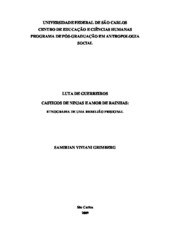Luta de guerreiros castigos de ninjas e amor de rainhas: etnografia de uma rebelião prisional
Abstract
This dissertation deals with the "mega-rebellion" of 2006 that occurred at the prison units of the State of São Paulo. Seen, felt and observed from inside a penitentiary facilities, I tried to analyze it as a symmetrical and complementary ritual of solidary, enduring, suffering, and memorable bodies who, from time to time, are fed back by police officers, in the form of blitzes and punishments as a feedback to oppress, coerce and impart pain and suffering capable of causing effects such as domestication and docilization of the bodies. The fabrication of these mobile and gentle bodies that transit at the various State prisons, after being transferred to other locations as a result of outcome of the rebellion, has granted the Primeiro Comando da Capital (PCC) [First Command of the Capital] more territorial expansion, strenghtened by its ideology and transformation of unequal bodies into equal bodies. This ethnography approaches on how the prisioners fought for the PCC, by feeding themselves, retroactively, of their own production when they consumed their subtances, their fluids and their matters during the fighting process and punishing. At last, the prison rebellion turned out to be a symmetrical - complementary ritual that marked the whole continuum of procedures and behavior of thinking and resistant bodies under the "ideals" of the PCC. Strenghtened by the eternal love of their partners and confident in the divine justice, the prisoners overcame the suffering and continued their walk to freedom.
